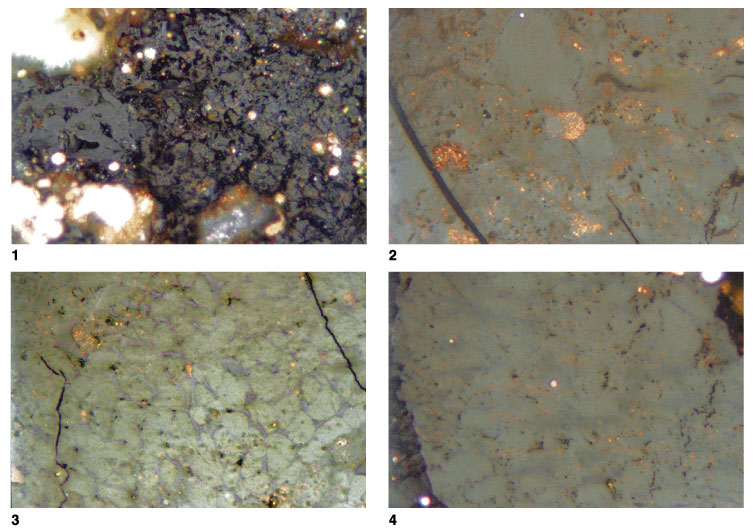
Plate P1.
Woody tissues preserved as vitrinite. 1.
T5945; Hole 1109C; 217.32 mbsf. Most of the gray reflecting material probably
represents cell contents, and some suberinite and resinite are also present but
are of extremely low reflectance. No major differences are obvious associated
with the cell structures. The wood represents a phytoclast deposited in a marine
setting. This type of vitrinite shows reflectances in the middle part of the
range and is the most appropriate for use in rank assessments (reflected light;
field width = 0.22 mm; vitrinite reflectance = 0.33%). 2.
T5945; Hole 1116A; 102.14 mbsf. Cell contents have been humified and show
slightly higher reflectances compared with the cell walls. Some small voids are
present within some cell lumens, resulting in the presence of bright internal
reflectances. These occurrences are referable to porigelinite. The ICCP (1971)
terminology would include the cell contents in collinite, whereas the SAA system
would place it within telovitrinite. Small differences are present in
reflectance between the cell contents and the cell walls and neither shows
distinctive fluorescence, so the fluorescence-mode image is not included
(reflected light; field width = 0.22 mm; telovitrinite reflectance =
0.51%-0.46%). 3. T5855;
Hole 1116A; 102.14 mbsf. Both the cell walls and the contents have been humified.
The cells have probably had additional humic matter added. Reflectances of the
cell contents are higher than for the cell walls. Cell walls include primary
cell walls but are sufficiently thick to indicate that some secondary cell wall
material must also be present. In the original ICCP terminology, the walls would
be termed telinite and the contents collinite. The SAA terminology would place
the whole field within the telovitrinite category. Fluorescence of both the cell
contents and walls is low (reflected light; field width = 0.22 mm; telovitrinite
reflectance = 0.54% [cell lumens], R = 0.36% [cell walls]). 4.
T5855; Hole 1116A; 102.14 mbsf. Woody tissue seen in section perpendicular to
the stem and preserved as vitrinite. Both the cell walls and the contents have
been humified. The cells have probably had additional humic matter added.
Reflectances of the cell contents are higher than for the cell walls. Cell walls
are dominantly primary cell walls, but local thickening suggests that other
tissue may be present. Reflectance contrast between the walls and the contents
is strong (reflected light; field width = 0.22 mm; telovitrinite reflectance =
0.40% [cell lumens], 0.18% [walls]). Click on image or number to see
enlargement.



![]()